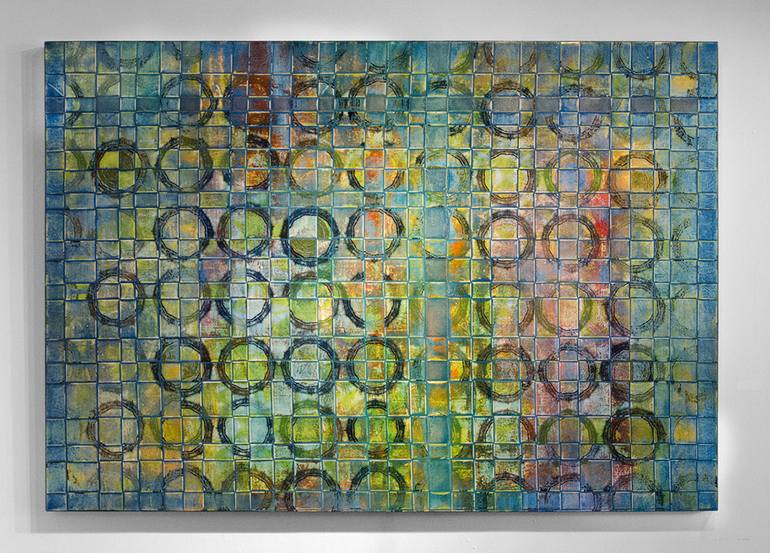







VIEW IN MY ROOM
Oh, Won't You Play A Song For Me? Painting
United States
Painting, Acrylic on Canvas
Size: 86 W x 60 H x 1.5 D in
Ships in a Crate
Artist Recognition

Featured in the Catalog

Artist featured in a collection
About The Artwork
Growing up, I went past the piano shop more times than I can count. With its mint green awning and faded 50’s motif, it blended into the dated landscape of downtown. 30 years later the courthouse has been demolished and relocated, in its place a Dollar General. While visiting my parents a few months ago I drove by the trusty piano shop and slowed to a near stop. The sign was gone and there was CAUTION tape neatly wrapped and tied around the building, like an oversized birthday present. Knowing this could only mean one thing I turned around, grabbed my camera and trotted up to the smashed windows hoping to find remnants of a past that I remembered. The faded Yamaha posters still garnered the walls and just there in the back were all of the abandoned pianos left for repairs and never picked up. I hopped through a window and with a sore throat from the harsh reality and injustice of the world I documented what wouldn’t be there the next time a drove by… This piece is an homage to all of the abandoned instruments of the world. The circular patterns are made from images of the strings and pads from the pianos, forever playing in loop. Why the Process is Part of the Message The first stage of production begins with two pieces of industrial grade, recyclable vinyl. A design is applied to each piece of vinyl using inks and acrylic paint. The paints are applied using silk screens and brushes. Each piece of vinyl is then cut into strips, one piece cut horizontal and the other vertical. After the strips have been cut they are woven and stretched over a traditional canvas frame. In order to reach matured textures, strips of canvas are sparingly interwoven with the vinyl. The next step is to apply several coats of paint over the woven vinyl in a specific pattern and color. After the coats have completely dried the piece is ready for sanding. The process of sanding allows for a variety of textures and other elements to surface, such as the base images (which were applied to the vinyl before the vinyl was cut into strips). Sanding has become the pinnacle of production, due to its order in the process and the effects achieved during the process. Once sanding is complete the piece is sealed and is prepared for viewing. A major part of the message each piece conveys rests in the process. The initial pieces of vinyl are likened to an initial event or occurrence where some things are remembered while others are lost. The images, which were once easily seen on the two large pieces of vinyl, become obscured when stripped and woven; all the information is there but not all of it is visible. Adding coats of paint can be likened to the addition of time as even more information becomes obscured, while the sanding reveals the imagery's current state losing it's original form forever. The memory, like the painting, pieces together elements, images and feelings; some obscured, some uncovered, all telling a story.
Details & Dimensions
Painting:Acrylic on Canvas
Original:One-of-a-kind Artwork
Size:86 W x 60 H x 1.5 D in
Frame:Not Framed
Ready to Hang:Not applicable
Packaging:Ships in a Crate
Shipping & Returns
Delivery Time:Typically 5-7 business days for domestic shipments, 10-14 business days for international shipments.
Handling:Ships in a wooden crate for additional protection of heavy or oversized artworks. Crated works are subject to an $80 care and handling fee. Artists are responsible for packaging and adhering to Saatchi Art’s packaging guidelines.
Ships From:United States.
Have additional questions?
Please visit our help section or contact us.
United States
Adreon Henry has always been curious about how things are constructed and has always had a drive to create. From a very early age he developed a very specific style through repeatedly drawing imaginary friends; these friends still exist today (i.e.“The Pendletons”). As a youth, his dedication to art intensified and he sold candy and various oddities to his peers in order to purchase his first screen-printing machine. He quickly utilized this media to make t-shirts of his favorite bands and prints from his drawings. He saved every dime and while still in high school he opened a skateboard shop and started his own line of skateboards featuring his designs. As a young adult, Adreon formed a band “Single Frame” and in 2000 the band decided to move to Austin, TX to pursue musical endeavors; this is when Adreon decided to commit to his artistic practice. In the intervening years, Adreon explored his creativity and found success in both music and art. Today he continues his creative endeavors, often working with the themes of time, community, and perspective. Adreon’s use of a variety of screen printing and painting techniques on non-traditional mediums has allowed him to create a signature visual style, while his many years as a musician gives him a strong foundation to create magnificent sound-scapes and interactive installations. Adreon lives and creates in Austin Texas.
Artist Recognition

Featured in Saatchi Art's printed catalog, sent to thousands of art collectors

Artist featured by Saatchi Art in a collection
Thousands Of Five-Star Reviews
We deliver world-class customer service to all of our art buyers.
Global Selection
Explore an unparalleled artwork selection by artists from around the world.
Satisfaction Guaranteed
Our 14-day satisfaction guarantee allows you to buy with confidence.
Support An Artist With Every Purchase
We pay our artists more on every sale than other galleries.
Need More Help?